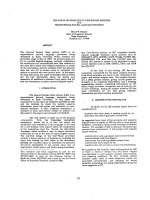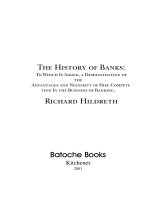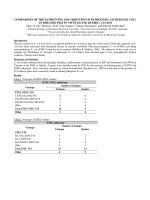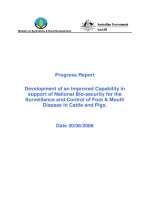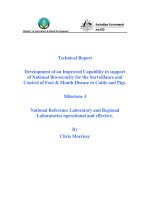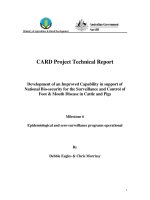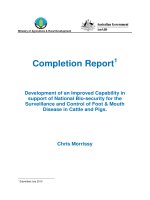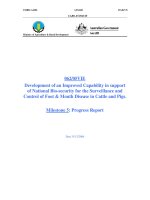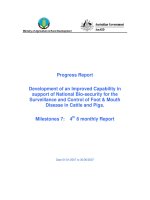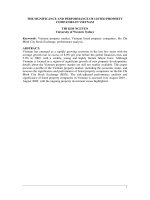The causes and consequences of condo hotel conversion in waikiki, hawaii
Bạn đang xem bản rút gọn của tài liệu. Xem và tải ngay bản đầy đủ của tài liệu tại đây (2.68 MB, 105 trang )
The Causes and Consequences of
Condo Hotel Conversion in Waikiki, Hawaii
by
Mark C.K. Lu
Bachelor of Arts, History
Brown University – 1995
Medicinae Doctoris
Tufts University School of Medicine – 2001
Submitted to the Department of Urban Studies and Planning in
Partial Fulfillment of the Requirements for the Degree of
MASTER OF SCIENCE IN REAL ESTATE DEVELOPMENT
at the
MASSACHUSETTS INSTITUTE OF TECHNOLOGY
September 2005
©2005 Mark C. K. Lu. All rights reserved.
The author hereby grants to MIT permission to reproduce and distribute publicly
paper and electronic copies of this thesis document in whole or in part.
Signature of Author
Department of Urban Studies and Planning
August 10, 2005
Certified by
Brian Anthony Ciochetti
Professor of the Practice of Real Estate
Thesis Supervisor
Accepted by
David M. Geltner
Chairman, Interdepartmental Degree Program in Real Estate Development
2
The Causes and Consequences of
Condo Hotel Conversion in Waikiki, Hawaii
by
Mark C. K. Lu
Submitted to the Department of Urban Studies and Planning on August 10, 2005
in Partial Fulfillment of the Requirements for the
Degree of Master of Science in Real Estate Development
ABSTRACT
This paper explores the causes and consequences of the recent conversions of hotels into ‘condo
hotels’ in Waikiki, Hawaii, through an examination of local and national real estate trends. Condo
hotels result from the conversion of hotels to individual condominium units operated as a hotel.
In the last few years forces driving a national residential real estate boom have carried the
concept of the condo hotel to the forefront of the public’s imagination. For developers, the
model of hotel conversion offers numerous advantages and has proven an effective bridge
between risk adverse lenders and developers seeking project financing. Developers and
condominium buyers alike value the services and branding hotel operations can bring to a
property. In Waikiki, condo hotels operate as a vehicle for the renovation and reinvention of
aging hotel stock. The product has proven exceptionally popular, yet the wholesale conversion
of aging hotel stock could have both positive and negative consequences for Waikiki or similar
communities. While condo hotels can upgrade a region’s accommodations infrastructure, some
allege it has the potential to disrupt local employment and undermine tax revenues. Others fear
demographic changes and social displacement not unlike the controversy over apartment
conversions in the 1970s. No doubt conversion of large numbers of hotels into condo hotels will
result in change but that change needn’t produce a negative outcome.
Thesis Supervisor: Brian Anthony Ciochetti
Title: Professor of the Practice of Real Estate
Acknowledgements:
In the course of preparation and research for this paper many individuals were invaluable
resources for support and guidance. I would like to thank Tony Ciochetti who managed to find
time while globe-trotting for the Center and Maria Vieira and all of the administrative and
support staff at the CRE. For the Hawaii based team I want to acknowledge the support and
wisdom of many including Professor Janine Clifford, Hawaii State researchers, local developers,
managers, brokers, consultants, and friends.
Table of Contents
Introduction
6
Chapter 1:
Background
9
Chapter 2:
Introduction to Waikiki
16
2.1: Geographic Definition
2.2: Economic Contribution
2.3: Development History
Chapter 3:
What is a Condo Hotel
27
3.1: Definitions
3:2: Condominium and Hotel – A Mixed-Use Model
3.3 Condominium Hotel – Condominium Ownership of a Hotel
Chapter 4:
4.1
Example Case: The Waikiki Hotel Exemplar
: The Hotel
4.2: The Owner
4.3: The Developer
4.4: The Management Company
4.5: The Buyers
4.6: The Guests
37
Chapter 5:
Causes of Conversion
48
5.1: Waikiki’s Aging Hotel Stock
5.2: Buyer Demographics
5.3
: Investment Attitudes
5.4: Pricing
5.5: Home Ownership
5.6: Advantages Over Competitors
5.7: Financing
5.8: International Buyers
Chapter 6:
6.1
Consequences of Conversion
66
: Legal Liability
6.2: Management and Governance
6.3: Unbundling of Property
6.4: Taxation
6.5: Hotel Inventory
6.6: Economy and Employment
Conclusion
92
Bibliography
95
Introduction
In the last decade years this country has witnessed one of the strongest and most prolonged rises
in the real estate markets ever recorded. A combination of indigenous and immigration
demographics, low interest rates, and a national shift in attitudes toward home ownership have
contributed to an unprecedented rise in residential values. This seemingly insatiable demand has
placed pressure on land resources and existing housing stock and encouraged developers to seek
creative means of introducing new product. Low interest rates have brought the costs of
ownership down to a level such that more Americans can afford to purchase not only their
primary residence but second home and investment properties. In Waikiki and other regions with
high concentrations of hotels, demand for second-home and investment product has emboldened
developers to pursue poorly performing hotels with the intention to acquire and convert into
condominium hotel ownership, also known as ‘condo hotels.’ This paper will address both
academic and lay pieces that explore the causes and consequences of condo hotels in Waikiki
within the framework of an emerging national phenomenon.
It is not surprising that the condo hotel concept has taken off in places like New York, Florida,
and Hawaii where condominiums have been an acceptable form of ownership for decades. 1
Condo hotels have been a legal form of ownership sine the 1960’s with the passage of the first
condominium legislation; however, despite some experimentation with the ownership structure
1
Warner, Arthur. Condominium: Concept, Control, Consumer Acceptance. Research Report, July 11, 1976.
College of Business Administration University of South Carolina (Columbia SC) p 29. Warner addresses local
markets but references those in Hawaii and New York.
over the years the concept went largely unnoticed until recently. Treading a fine line between real
estate and a security, Waikiki condo hotels serve a dual role for many buyers as a second home
and an investment product. For the buyer the product is an affordable, low-maintenance, and
high-amenity alternative to single family or conventional condominium second-home ownership.
For hotel owners, condominium hotel conversion offers a high value opportunity to transfer
ownership of marginal hotel properties. For both developers and lending institutions, the upfront
sales of condominium hotel units mitigate development risk and in the case of new construction,
provide the basis for financing ground-up hotel construction. The result is what some have called
an “unprecedented alignment of economic interests of developers, consumers, hotel operators,
and lenders.” 2
Hotel conversions represent only a small percentage of condominium creation
nationally. 3
Given that condo hotels are limited to a few regional markets and have only become more
widespread in the last four to five years there is limited quantitative data to undertake rigorous
analytical studies. Despite this, in communities where conversion has occurred, some concerns
regarding the consequences of hotel conversions have emerged in the lay press. In Waikiki, the
3,331 condo hotel rooms represent just under 10% of the 31,717 total lodging units for the area.
Of these 3,331 units, industry sources estimate between 300 to 900 units have been permanently
removed from the short-term hotel rental pool in Waikiki.
2
Butler, Jim and Maisnik, Guy. “Condo Hotels: Marking Them Work Involves Challenges and Rewards.” Urban
Land Urban Land Institute (ULI). February 2005 p.32. See also comments by Regent Street Advisors in Parets,
Robyn Taylor. “Why Condo Hotels are a Hot Concept.” National Real Estate Investor. May 1 2005. p.89.
3 For more on the current wave of residential condominium conversions refer to Gose, Joe “Condo Conversion
Craze.” National Real Estate Investor Online. Jun 1, 2004.
Unlike previous housing conversion debates which dealt with tenant displacement or
gentrification, most hotels in Waikiki or elsewhere do not house longer-term residents who
would need to relocate. Hence it could be surmised that any contention regarding conversion
might be tempered.4 In fact, equally important issues arise such as what will be the effect of
wholesale conversions of hotels into individually-owned condominiums on the local economy –
especially in communities wholly reliant on tourist activity? In other words, whereas conversion
of apartments to condominiums raises issues of displacement of tenants, conversion of hotel
rooms to condo hotels potentially results in displacement of guests. In communities such as
Waikiki, South Florida, and to some extent New York City, hotel keys not only represent tourist
lodging but basis by which tourists can experience and consume local goods and services.
Therefore, to many, the conversion of hotel keys to condominium units threatens not only the
supply of short-term tourist housing but eventually undermines the fundamental drivers of local
and state economies.
4
The scenario might be different were the hotels in question single room occupancy (SRO) or rooming-house
properties which sometimes can serve as transient housing for those who cannot afford or cannot find more
permanent residential housing. On occasion, the sale, demolition or conversion of such properties can stimulate a
community debate. See Lobbia, J.A. “Down in the Old Hotel Tower & Tenements: Landlords Trade Tenants for
Tourists at SROs.” The Village Voice (New York, NY) September 30, 1998.
11
Chapter 1
Background
There is a substantial collection of academic and industry literature regarding condominiums as
form of ownership. Condominium ownership exists in all forms of real estate products including
commercial, industrial, retail and residential properties. While the legal structure for condo
hotels has been in place for many years, only recently have numbers of condo hotels risen to
levels where public interest has been aroused. Condo hotels have been an inventory component
to Waikiki’s housing stock for decades although only recently have the numbers of condo hotels
begun to elicit discussion in the lay and academic press. Since 2000 approximately 2300 of
Waikiki’s 31,717 hotel rooms, or seven percent of total lodging inventory, have been converted
to condo hotel rooms.
As a result of mostly newspaper and industry publication coverage of this recent trend in Waikiki
and other locations such as a New York and Florida, there is not a great deal of historical or
academic literature on condo hotels. There is some literature on resort condominiums which
focuses on development techniques and the legal framework of seasonal-use condominiums, but
the properties which they detail were never operated as full service hotels... Hotel literature
addresses the financing, development and operational aspects of the industry but few articles
delve into the condominium conversion or ownership of these properties. In the past older hotels
12
have been converted to apartment buildings or residential housing but only recently have fully
operating hotel properties been structured under condominium ownership.
Starting from the 1960’s, when the first condominium legislation was passed, articles and books
have addressed, among many other topics, the optimal location, financing, design, construction,
marketing, and legal framework of what was then a new structure of ownership. The next decade
witnessed greater acceptance of the condominium idea and more widespread construction and
conversion of condominiums in national markets. According to Michael J. Whinihan’s
retrospective 1984 AREUEA Journal article entitled “Condominium Conversion and the Tax
Reform Acts of 1969 and 1976,”5 legislative changes (notably, reduced rental housing tax
benefits) combined with market forces to provide an important stimulus for the residential
condominium conversions of the 1970’s and 1980’s.
The legal, development, and management issues surrounded condominium development are
amply addressed in Keith Romney’s 1974 Condominium Development Guide: Procedures,
Analysis, Forms which includes a useful section on resort condominiums. 6 The condominiums on
which Romney focuses may be characterized as resort retreats with condominium developments
such as his example of a seasonal mountain resort. Although the property is managed for owners
as a resort and a rental pool may be established, the product and its
5
Whinihan, Michael J. “Condominium Conversion and the Tax Reform Acts of 1969 and 1976.” American Real
Estate and Urban Economics Association (AREUEA) Journal Vol 12, no. 4, 1984. pp 461-472.
6
Romney. Keith and Romeny, Brad. Condominium Development Guide. Warren, Gorham & Lamont (Boston,
MA). 1983. This publication is continually revised and supplements are published on a regular basis. Resort
condominiums (often in seasonal locations such as mountain resorts) are addressed though there is only slight
mention of condo hotels.
implications arguably differ from the large scale conversion of existing hotel ownership in
Waikiki from corporate ownership to individual room/key ownership in an operating hotel.
Nevertheless, elements of structure, management, and legal considerations of resort
condominiums remain relevant to the framework of condo hotel conversion in Waikiki today.
Works such as Romney’s Development Guide serve as a framework for the understanding the
mechanics of development, other authors have focused on the impact and implications of
condominium development and conversion. Starting with the wave of conversions that took
place during the 1970’s and 1980’s researchers began to address the longer term issues associated
with condominiums such as land or property use and community dislocation. In the eyes of some
observers during this period wholesale apartment conversions appeared to threaten the social
fabric of neighborhoods and potentially disrupt the quality and character of entire cities and
towns. Some believe that in today’s Waikiki and other communities, the conversion of hotel
inventory into condominiums has the potential to undermine the local tourist-based economy. As
hotels are converted into condominium ownership it is possible that fewer available hotel rooms
will result if owner use is high thereby providing fewer options for visiting guests. But in the
1970s it was the conversion of existing housing stock, especially when relating to neighborhoods
where affordable housing or former rent-controlled properties were being transformed on a grand
scale that became a contentious issue. Displacement of individuals from affordable rental
housing and changes in the character of communities no doubt resulted, but the effects can be
viewed as both positive and negative - while communities did change, home
ownership became a reality for many who might not otherwise been able to afford a singlefamily home.
Several studies examined the effect of apartment conversion in cities such as Brookline,
Massachusetts. Dinkelspiel, Uchenick and Selesnick, in Condominiums: The Effects of
Conversion on a Community (1981) concluded that “conversion has not markedly changed the
socioeconomic character of most (though not all) neighborhoods.” Even so, conversion of a
substantial number of apartment buildings in an area will raise a broad range of difficult issues
for the community and present a series of conflicts for it resolve. 7 In addition to social
displacement, Dinkelspiel’s study reviewed the potential changes in tax revenues, use of services,
and the longer-term demographics of Brookline as an example community. Unless a significant
number of families with children were to replace existing residents the authors found that “a
community is not likely to have to respond in any major way to conversion in terms of the
services it provides.” Although findings of different community studies vary and to some extent
the debate still persists, most understand that the process of residential condo conversion has
benefits and deficits on both the individual and the community level. In essence, most have
come to accept that conversion reflects free-market forces which govern commerce in this
country. While apartments are an important revenue source for their owners it would be fair to
say that apartments are not as an industry the drivers of economies. Hotels, on the other hand,
can play a key role in the fiscal health of communities reliant on tourism.
7
Dinkelspiel, John, Uchenick, Joel, and Selesnick, Herbert. Condominiums: The Effects of Conversion on a
Community. Auburn House Publishing Company (Boston, MA). 1981. P. 147. For further discussion see also:
Moe, Kari. Analysis of the Condominium Conversion Debate. A study prepared for the Boston Neighborhood
Network. March 5, 1981. Additionally Boroff, Janey Bishoff. The Market Dynamics of a Condominium Conversion
from a Supply Perspective – A Town in Turmoil. Thesis: MIT DUSP 1979.
Just as much as been written regarding fundamentals in condominiums and conversion so also
has much been written regarding the dynamics of hotel markets and operations. Recent academic
literature has focused on consumer demand stratification and occupancy such as Gat’s Journal of
Real Estate Finance and Economics (JREFE) article “Toward a Theory of the Intraurban Market
for Hotel Services,” (1998). Gat’s article attempts to predict which hotels in a given area are
likely to empty or full given their offering of hotel services and client demand. Hotel services
and product differentiation are no doubt contributory forces to success or failure of existing hotel
ventures in Waikiki... Whereas in the 1980’s Waikiki offered high-end, mid-priced, and budget
hotel options for visitors, in the last decade neglect and physical depreciation degraded many
mid-priced hotels to budget status creating a gap in supply differentiation. These mid-level (now
budget hotels) have been prime candidates for conversion. While this subject gives some clues
as to the forces encouraging conversion in Waikiki it is clear that many contributory factors are at
hand and most buyers of condo hotel units have little consideration of product differentiation
when making a decision to purchase.
Aside from poor differentiation, hotel conversion in Waikiki is also the result of a legacy of
excess supply, much of it built years before in periods of growth and speculation. In their 1998
study in Real Estate Economics Wheaton and Rossoff review the continued inadequacy of the
supply side of the hotel sector to efficiently meet demand cycles. 8 Although there is evidence of a
“very strong market cycle,” in place measured growth in line with demand, the supply side of
8
Wheaton, William, Rossoff, Lawrence. “The Cyclic Behavior of the U.S. Lodging Industry.” Real Estate
Economics. 1998 Volume 26, 1: pp 67-82.
the industry tends instead to move forward in response patterns that are “slow and hence prone to
instability.” The authors note that “quicker response by rents and sooner supply deliveries are
necessary to smooth the cycle and stabilize the model.” 9 Conceivably, the underlying rush to
convert hotels into condominiums in Waikiki is a free market adaptation to supply ‘new’
renovated and repositioned product quickly to market demand. Renovations of existing hotels
need little if any new zoning relief or difficult to obtain permitting, and can be back on the
market within 9-18 months. What significant renovations do require is funding. As will be
discussed, condo hotels fill this need through presales to individual owners. Individual buyers
currently pay a premium per square foot over what hotel operators can justify on a cash flow
basis. By providing a renovated model unit to drive sales, developers can sell out a hotel property
quickly and apply commitments to secure financing for renovations. This process arguably
creates a more efficient market with better differentiated product and heightened response time
since hotel units emerge quickly after refurbishment and rent out at a higher premium to meet
demand.
There are news articles that address many of the potential drivers for the recent trend of condo
hotel construction and conversion nationally; however, there are few published in-depth
academic works focused on the recent wave of condominium hotels. According to several
contacts, hotel conversion to condominium hotels in Waikiki specifically has been a notable
trend since the late 1990’s with an acceleration of activity since around 2003. Initially, it is fair
to say that few articles resulted during the early part of this trend either locally in Waikiki or
9
Wheaton, William, Rossoff, Lawrence. “The Cyclic Behavior of the U.S. Lodging Industry.” Real Estate
Economics. 1998 Volume 26, 1: p 81.
17
nationally due to lack of public awareness of the product – which was by many viewed as a
‘white elephant’ real estate product or investment. In recent years the emergence of
condominium hotel product in several markets nationally has brought more public and some
academic attention. It is important to note that in the process of research it is apparent that a
number of research works on the trend are currently being prepared especially regarding Waikiki.
Of particular significance is an ongoing study commissioned by the State of Hawaii, to be
compiled by Joseph Toy of the private consulting firm Hospitality Advisors LLC, on the effects
of hotel conversion on Oahu. Although several news articles suggest that the study would be
complete in April of 2005, at the time of this publication the project had not yet been finished
– a state economist expects the study to be available at the end of August 2005. 10 If available
before binding this material may be added as an Appendix attachment.
10
Clearly there is ample indication that this is a topic of concern for the government, businesses, employees, and
citizens of Waikiki. A similar study had been commissioned by the private organization American Association of
Resort Developers (ARDA) regarding the impact of conversion for the island of Maui. At the time of completion of
this paper the State of Hawaii study had not yet competed; however, this material may be added as an appendix
attachment.
18
Chapter 2
Introduction to Waikiki
2.1: Geographic Definition
From a geographical perspective Waikiki is a district within the City & County of Honolulu,
located on the south shore of the island of Oahu. The area, delineated from Honolulu’s land
mass by man-made brackish canals, known as the Ala Wai, is comprised of roughly 1 square mile
(600 acres) and represents about 1/100th of 1% of the state's land area.
11
Waikiki is typically
considered the land circumscribed by the Ala Wai to the north and the ocean to the south, but
many would also include the adjacent Ala Moana hotel, yacht club, and convention center as
inclusive. Land characteristics of the area include sandy beachfront (with sand replenished by the
city from nearby island of Molokai), former low lying swamp and beachfront lands with dredge
fill from the canals.
A map of the area including the locations of the majority of hotels in included on the following
page.
11
Waikiki Business Improvement District Website: />
Map Of Waikiki
2.2: Economic Contribution
About 19,000 people claim residency in Waikiki (from 14,000 residential units) which on an
average day hosts 70,000 visitors and 37,500 employees. The real property use composition of
Waikiki reflects its 20th century legacy as a ‘place of hospitality.’ The area’s focus on hotels,
retail, entertainment, and other service industries constitute approximately 75% of the businesses
on Waikiki.12 Many non-resort related business, such as investment groups, still maintain offices
in Waikiki as it is considered an important high visibility location that rivals ‘downtown’
Honolulu. The Hawaii Department of Business, Economic Development and Tourism (DBEDT)
has estimated Waikiki’s 2002 contribution to the state economy from its nearly 1,600 businesses
in Table 1: Contribution to Hawaii’s Economy 2002. Within the limited confines of this area,
Waikiki generates half of the state's visitor industry expenditures, up to13% ($5.2 billion) of the
Gross State Product, 8-10% of all jobs, and 12% of all taxes. 13 DEBDT notes that Waikiki
business alone paid out an estimated $807 million in wages for 2000. A good portion of these
wages find their way back into the Waikiki economy resulting in a greater “induced impact” of
visitor related expenditures.
12
DBEDT: Establishments in Waikiki 2000. Of 1607 establishments on Waikiki, 1208 are classified as: Retail
Trade; Accommodations & Food Services; Arts, Entertainment and Recreation; or Real Estate and Rental Leasing.
13 Waikiki Business Improvement Website: />
Table 1. Contribution to Hawaii's Economy by Statewide
Visitor Industry and Waikiki, 2002
Statewide
Visitor Industry
Contribution
Waikiki Contribution
to Economy
to State Economy
Measure of
Tourism
Percent of
Number
Percent of
State Economy
Number
State Economy
Direct Impact¹
Gross State Product (GSP)²
Civilian Jobs³
State & Local Taxes ($millions)
Direct and Indirect
NA
NA
NA
NA
122,219
17.0%
55,610
7.7%
$776.3
21.6%
$353.2
9.8%
$7,973.6
17.3%
$3,628.0
7.9%
160,787
22.3%
73,158
10.2%
$949.3
26.4%
$431.9
12.0%
4
GSP4 ($millions)
Civilian Jobs³
State & Local Taxes ($millions)
NA: Not Applicable.
¹ Measures the impact of visitor expenditures on only those firms that sell directly to visitors.
² In this Input-Output analysis, direct and indirect GSP are not readily separated.
³ Civilian jobs include wage and salary jobs plus self-employed but exclude non-civilian military jobs.
4
Measures the impact of visitor expenditures through all firms that contributed to goods and services sold to
visitors.
Source: DBEDT.
According to the 2000 Census, the visitor housing industry, with approximately 32,000 rooms in
high-rise hotels, resorts, and residential complexes, constitutes about 20% of all businesses in
Waikiki. In addition, visitor housing in Waikiki represents nearly 90% of all of Oahu’s rooms,
and 45% of the states total inventory (Table 2: Inventory of Visitor Units , 2002). Thus, not
only does this industry define much of the architecture and land use in Waikiki, it represents a
key foundation for the local economy. In 2002 condominium hotels represented a small but
notable portion (about 10%) of Waikiki’s total visitor units and nearly 97% of all such product on
Oahu. Conventional hotels supply the majority of visitor housing units in Waikiki and over half
of the state’s hotel rooms may be found in Waikiki.
Table 2. Inventory of Visitor Units, 2002
Waikiki
Oahu
State
% in
Type
ALL UNITS
% in
Number Number Waikiki Number Waikiki
31,717
36,457
87.0%
70,783
44.8%
Apartment/hotel
212
307
69.1%
414
51.2%
Bed & Breakfast
0
28
0.0%
485
0.0%
3,331
3,442
96.8%
15,731
21.2%
153
213
71.8%
339
45.1%
27,505
31,442
87.5%
49,442
55.6%
Indiv. Vacation Unit
147
269
54.6%
1,704
8.6%
Other
369
756
48.8%
2,668
13.8%
Number & percent of above units classified as
921
981
93.9%
4,967
18.5%
Condominium Hotel
Hostel
Hotel
Registered Time-share
Source: DBEDT, 2002 Visitor Plant Inventory
2.3: Development History
Waikiki’s location has always been valuable resort real estate. The native Hawaiian definition of
‘Waikiki’ translates into ‘sprouting water’ which references the area’s pre-colonial history as a
place of springs, fishponds, streams, and gardens. The area was a royal domain used by native
rulers as a place of relaxation, healing, and rejuvenation.
The last hundred years in Waikiki has been a history dominated by development. After the
American business-interest backed 1893 overthrow of the Monarchy by the United States
Government Waikiki’s royal cultural past was largely ignored as mainland corporate interests
focused on extracting exportable goods, such as sugar cane, from the islands. By 1901, Waikiki
as a resort destination was reborn in an area adjacent to former royal grounds. Captain William
Matson opened the Moana Hotel, Waikiki’s first hotel, as a stopover for passengers on his luxury
steamship line, known as the Matson Navigation Company. 14 The introduction of this high-end
hotel establishment in Waikiki grounded the location as a prestigious resort location in the
imagination of overseas visitors. From the early 1900’s through the end of the 1920’s Waikiki
hosted well-heeled notables from around the world who came to experience the South Pacific
and a ‘gateway’ to Asia.
14
/>
During the Second World War and the post-War period Hawaii became both a destination and a
stop over point to Asia for US servicemen. The combination of the post-War boom economy,
statehood, and the rise of air travel fueled dramatic growth of Waikiki as a tourist destination for
all Americans. Waikiki in the 1950’s and 1960’s saw tremendous growth in visitors and hotels to
Waikiki. Historian Don Hibbard in his book The View of Diamond Head: Royal Residence to
Urban Resort (1994), notes that visitors to Hawaii (who nearly all passed through Waikiki) in the
mid-1950s numbered around 100,000 annually; yet, by 1959 that number had increased to
250,000. By 1964 the number had ballooned to 500,000 annually with hospitality services
racing to keep pace.15 Moreover, new options for visitors and investors in Waikiki’s resort
economy emerged with Act 180, the nation’s first condominium law, which passed the Hawaii’s
state legislature in 1961. The Ilikai hotel, constructed in 1964, was Waikiki’s first residential
condominium and hotel complex with over 1000 units. Interestingly, the project was originally
conceived entirely as residential resort condominiums but due to the novel nature of the product
did not sell well enough to justify devoting the entire complex to condos so both hotel and
condominiums exist within the same campus.16
Condominium development in Hawaii exploded in the 1970’s through the 1980’s and skillfully
crafted sales pitches to vacationers in ‘paradise’ ensured many units were sold to absentee
owners not intimately connected to the stewardship of development on Waikiki. 17 Most new
construction was not well regulated and the city lacked a comprehensive zoning and open space
15
Hibbard, Don and Franzen, David. The View From Diamond Head: Royal Residence to Urban Resort. Editions
Limited Publishers (Honolulu, HI). Second Edition 1994. pg. 143.
16
www.shellvacationsclub.com/shownews.html?id=171
17
Press Release - Aston Hotels and Resorts: A 60 Year History:
/>
